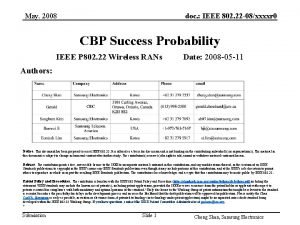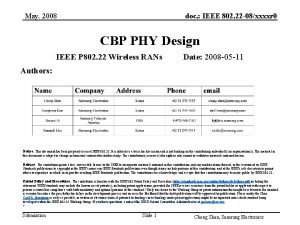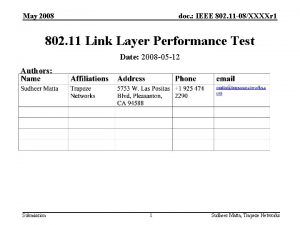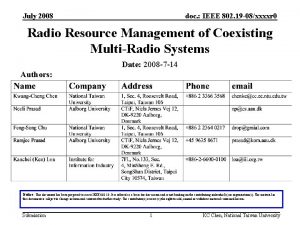May 2008 doc IEEE 802 22 08xxxxr 0






- Slides: 6

May. 2008 doc. : IEEE 802. 22 -08/xxxxr 0 Geolocation Database Interface IEEE P 802. 22 Wireless RANs Date: 2008 -05 -11 Authors: Notice: This document has been prepared to assist IEEE 802. 22. It is offered as a basis for discussion and is not binding on the contributing individual(s) or organization(s). The material in this document is subject to change in form and content after further study. The contributor(s) reserve(s) the right to add, amend or withdraw material contained herein. Release: The contributor grants a free, irrevocable license to the IEEE to incorporate material contained in this contribution, and any modifications thereof, in the creation of an IEEE Standards publication; to copyright in the IEEE’s name any IEEE Standards publication even though it may include portions of this contribution; and at the IEEE’s sole discretion to permit others to reproduce in whole or in part the resulting IEEE Standards publication. The contributor also acknowledges and accepts that this contribution may be made public by IEEE 802. 22. Patent Policy and Procedures: The contributor is familiar with the IEEE 802 Patent Policy and Procedures http: //standards. ieee. org/guides/bylaws/sb-bylaws. pdf including the statement "IEEE standards may include the known use of patent(s), including patent applications, provided the IEEE receives assurance from the patent holder or applicant with respect to patents essential for compliance with both mandatory and optional portions of the standard. " Early disclosure to the Working Group of patent information that might be relevant to the standard is essential to reduce the possibility for delays in the development process and increase the likelihood that the draft publication will be approved for publication. Please notify the Chair Carl R. Stevenson as early as possible, in written or electronic form, if patented technology (or technology under patent application) might be incorporated into a draft standard being developed within the IEEE 802. 22 Working Group. If you have questions, contact the IEEE Patent Committee Administrator at patcom@iee. org. > Submission Slide 1 Cheng Shan, Samsung Electronics

May. 2008 doc. : IEEE 802. 22 -08/xxxxr 0 The WRAN-DB Interface in D 1. 0 • A WRAN system enquiries the geo-location database (DB) for the maximum allowed EIRPs on a set of frequency channels for each of its devices; • When a query is received from the WRAN, the DB calculates the EIRP cap for the enquiring device and feeds back; • The WRAN could enquiry the database – when a device is powered up, or – on a periodical basis during communication, or – triggered by pre-defined events • E. g, when inconsistency is found between DB query results and sensing results; Submission Slide 2 Cheng Shan, Samsung Electronics

May. 2008 doc. : IEEE 802. 22 -08/xxxxr 0 DB-Query Scenario (1/2) Submission Slide 3 Cheng Shan, Samsung Electronics

May. 2008 doc. : IEEE 802. 22 -08/xxxxr 0 DB-Query Scenario (2/2) Submission Slide 4 Cheng Shan, Samsung Electronics

May. 2008 doc. : IEEE 802. 22 -08/xxxxr 0 Suggested WRAN-DB Interface • WRANs register devices in DB when the devices become operational; WRANs de-register devices when the devices become inactive; • Instead of passively responding queries from WRAN, the DB shall actively “push” EIRP data into the WRAN system when necessary; Submission Slide 5 Cheng Shan, Samsung Electronics

May. 2008 doc. : IEEE 802. 22 -08/xxxxr 0 Pros and Cons • Pros – Further reducing the interference risk when incumbent appears; – Improve WRAN throughput by saving sensing quiet periods; – Improving the spectrum utilization efficiency when channel status changes from unavailable to available; • Cons – Increased complexity at the DB side to keep a list of registered devices; Submission Slide 6 Cheng Shan, Samsung Electronics











